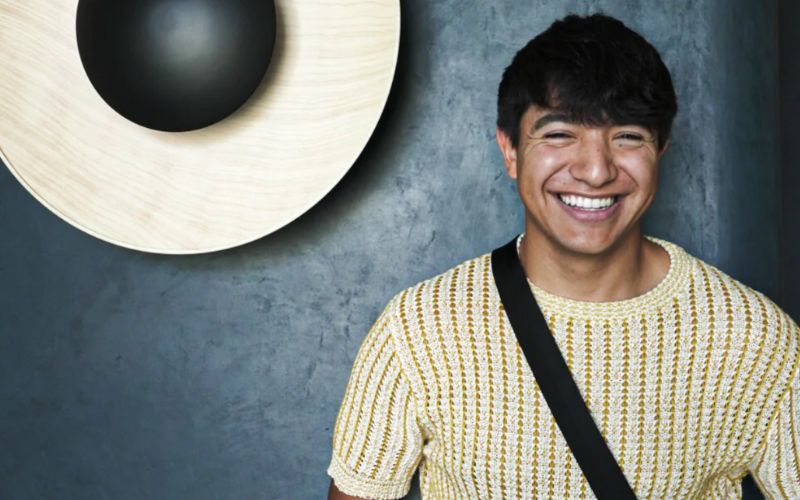
- Details
- By Kaili Berg
Next month, the California Academy of Sciences' NightLife series, Intersections, will showcase the popular Indigenous-owned brand Urban Native Era in a cross-cultural fashion show.
At NightLife, part of the California Academy of Sciences’ weekly 21-and-older events, guests can delve into the natural history museum after hours, enjoy cocktails and explore the cross-cultural connections, personal identity, and shared humanity fostered through dance, fashion, and music.
Scheduled this Thursday, April 4, in San Fransisco, the fashion edition of NightLife Intersections will feature a panel discussion and a live fashion show, showcasing the works of local artists.
Among the panelists are Alia Sharrief, founder of the Hijabi Chronicles, dedicated to showcasing Muslim women in hip-hop; Cindy Phan, representing the Ao Dai Festival, which honors Vietnamese culture and history through fashion; and Joey Montoya, the visionary behind Urban Native Era, showcasing Indigenous representation in the fashion world.
Montoya, a member of the Lipan Apache tribe, talked to Native News Online about the inspiration behind Urban Native Era, how he incorporates Indigenous culture into his designs, and how he sees fashion continuing to become a core part of Indigenous gatherings.
This interview has been edited for clarity and length.
Your brand, Urban Native Era, aims to increase the visibility of Indigenous peoples through fashion and design. Could you share more about the inspiration behind starting this initiative?
Toward the end of 2012, I was inspired by Indigenous-led movements in Canada called Idle No More. I began sharing images and photos of rallies and flash mob-like round dances to a Facebook page titled Urban Native Era. The fashion piece came in May, 2013, when I started to figure out other ways I could reach broader audiences. Since then the brand has been focusing on fashion and design a lot because I believe it plays a huge role on how to move through this world.
How do you incorporate elements of Indigenous culture and identity into your designs while also making them accessible to a broader audience?
When I first started incorporating clothing, I designed large graphic art pieces of Indigenous issues we would amply. The graphic art pieces reflected movements such as MMIW in 2014, Mauna Kea, Standing Rock, and Oak Flat. I developed my artistic eye in college and after college, I wanted to take a more minimal approach. From our ‘You Are On Native Land’ statement piece to our Hummingbird logo, I’ve been focusing on pieces that aren't too “loud", that are subtle, but make a statement.
I believe these things are what have made it appealing to the broader audience. These past two years, we have also been working on basics such as blank white tees, socks, etc. These pieces of garments don’t necessarily scream what people consider “Indigenous” but are made by an Indigenous-owned company. What we are showcasing in the fashion show will be something people have never seen from us before.
In what ways do you see fashion serving as a platform for cultural expression and empowerment, particularly for Indigenous communities?
Fashion has always been an integral part of Indigenous culture. Today, fashion continues to become this way of expressing who we are, the communities we come from, and our connection to land or places. I see fashion continuing to become a core part of Indigenous gatherings and events. For example, The Black Hills Powwow and the Reservation Economic Summit (RES) this year both had fashion shows. I think it's a beautiful way to express ourselves, to feel seen, and will lead to more Indigenous fashion designers and creatives in the future.
What are you hoping audiences will take away from the upcoming show and what are you looking forward to the most?
This will be our first fashion show, I hope the audience really takes in the whole experience, from the Original soundtrack we have designed for the show to these completely new pieces. I want folks to leave inspired and for them to begin this process of examining what fashion really means to them.
Click here for more information on NightLife Interactions: Fashion.
More Stories Like This
Watermark Art Center to Host “Minwaajimowinan — Good Stories” ExhibitionMuseums Alaska Awards More Than $200,000 to 12 Cultural Organizations Statewide
Zuni Youth Enrichment Project Takes Top Emerging Artist Apprentices to Phoenix for Artistic Exploration and Cultural Immersion
From Dishwasher to Award-Winning Chef: Laguna Pueblo's Josh Aragon Serves Up Albuquerque's Best Green Chile Stew
Rob Reiner's Final Work as Producer Appears to Address MMIP Crisis
Help us defend tribal sovereignty.
At Native News Online, our mission is rooted in telling the stories that strengthen sovereignty and uplift Indigenous voices — not just at year’s end, but every single day.
Because of your generosity last year, we were able to keep our reporters on the ground in tribal communities, at national gatherings and in the halls of Congress — covering the issues that matter most to Indian Country: sovereignty, culture, education, health and economic opportunity.
That support sustained us through a tough year in 2025. Now, as we look to the year ahead, we need your help right now to ensure warrior journalism remains strong — reporting that defends tribal sovereignty, amplifies Native truth, and holds power accountable.
 The stakes couldn't be higher. Your support keeps Native voices heard, Native stories told and Native sovereignty defended.
The stakes couldn't be higher. Your support keeps Native voices heard, Native stories told and Native sovereignty defended.
Stand with Warrior Journalism today.
Levi Rickert (Potawatomi), Editor & Publisher


